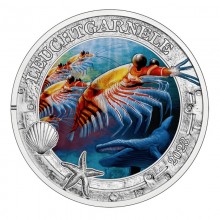





Austria 2023 3 euro colour collector coin glowing in UV - Antarctic krill from series "Luminous Marine Life"
This is the third 3 euro coin in the "Luminous Marine Life" series.
When the special UV torch is shone on the coins’ reverse, the Antarctic krill stands out clearly in the centre, its shell shimmering yellow-orange and legs light blue. The krill is framed by a wide band, reminiscent of an old-fashioned porthole, that frames the aquatic scene on the coin’s reverse. As on all the coins in the series, a shell and a starfish can be seen to the left and below.
All 12 of the magical sea creatures in the Luminous Marine Life series are shown in silhouette on the coin’s obverse. Air bubbles up between them and a tail fin disappears beneath the waves to the right.
Antarctic krill is a small swimming crustacean that lives in large schools, called swarms, sometimes reaching densities of 10,000–30,000 individual animals per cubic metre in the Antarctic waters of the Southern Ocean. It feeds directly on phytoplankton, mainly on diatoms and other plant plankton. Antarctic krill directly ingest phytoplankton cells, which no other animal of krill size can do. This is accomplished through filter feeding, using the krill's highly developed front legs which form an efficient filtering apparatus: the six thoracopods (legs attached to the thorax) create a "feeding basket" used to collect phytoplankton from the open water. In the finest areas the openings in this basket are only 1 μm in diameter. In lower food concentrations, the feeding basket is pushed through the water for over half a metre in an opened position, and then the algae are combed to the mouth opening with special setae (bristles) on the inner side of the thoracopods. Antarctic krill can scrape off the green lawn of ice algae from the underside of drift ice. Krill have developed special rows of rake-like setae at the tips of their thoracopods, and graze the ice in a zig-zag fashion. One krill can clear an area of a square foot in about 10 minutes (1.5 cm2/s). Recent discoveries have found that the film of ice algae is well developed over vast areas, often containing much more carbon than the whole water column below. Krill find an extensive energy source here, especially in the spring after food sources have been limited during the winter months.
Antarctic krill grows to a length of 6 centimetres (2.4 in), weighs up to 2 grams (0.071 oz), and can live for up to six years. It is a key species in the Antarctic ecosystem and in terms of biomass, is one of the most abundant animal species on the Earth. Antarctic krill is nutritional basis of many other marine animals in Antarctica, including whales, seals, fish, squid, penguins, albatrosses and many other species of birds.
Krill use an escape reaction to evade predators, swimming backwards very quickly by flipping their rear ends. This swimming pattern is also known as lobstering. Krill can reach speeds of over 0.6 metres per second (2.0 ft/s).
Krill are often referred to as light-shrimp because they emit light through bioluminescent organs. These organs are located on various parts of the individual krill's body: one pair of organs at the eyestalk (cf. the image of the head above), another pair are on the hips of the second and seventh thoracopods, and singular organs on the four pleonsternites. These light organs emit a yellow-green light periodically, for up to 2–3 s. They are considered so highly developed that they can be compared with a flashlight. There is a concave reflector in the back of the organ and a lens in the front that guide the light produced. The whole organ can be rotated by muscles, which can direct the light to a specific area. The function of these lights is not yet fully understood; some hypotheses have suggested they serve to compensate the krill's shadow so that they are not visible to predators from below; other speculations maintain that they play a significant role in mating or schooling at night.
Data sheet